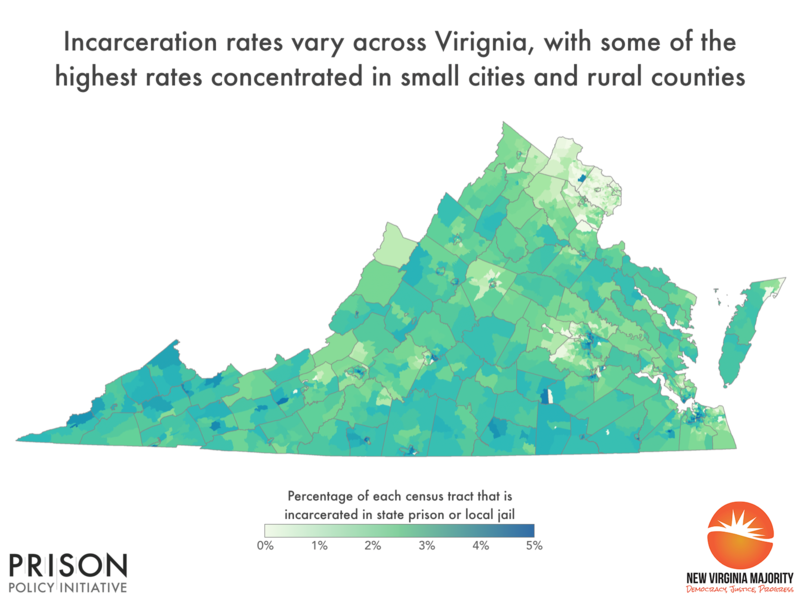New data reveals where people in Virginia prisons and jails come from
Report shows every community is harmed by mass incarceration
July 14, 2022
Today the New Virginia Majority and the Prison Policy Initiative released a new report, Where people in prison come from: The geography of mass incarceration in Virginia, that provides an in-depth look at where people incarcerated in Virginia state prisons and local jails come from. The report also provides ten detailed data tables — including neighborhood-specific data for Arlington, Norfolk and Richmond — that serve as a foundation for advocates, organizers, policymakers, data journalists, academics and others to analyze how incarceration relates to other factors of community well-being.
The data and report are made possible by the state’s landmark 2020 law that requires that people in prison and jail be counted as residents of their hometown rather than in prison cells when state and local governments redistrict every ten years.
The report shows:
- Every single county — and every state legislative district — is missing a portion of its population to incarceration.
- Many of the state’s least populous counties, including Buchanan, Brunswick, Lee, and Dickinson, have among the highest incarceration rates.
- There are dramatic differences in incarceration rates within communities. For example, more than half of the people in prison or jail from Richmond come from just 22 of the city’s more than 140 neighborhoods. These neighborhoods have historically been victims of dramatic “redlining”.
Data tables included in the report provide residence information for people in Virginia state prisons and jails at the time of the 2020 Census, offering the clearest look ever at which communities are most impacted by mass incarceration. They break down the number of people locked up by county, city, town, zip code, legislative district, census tract and other areas.
The data show the counties with the highest state prison and local jail incarceration rates are Buchanan (1,246 per 100,000 residents), Brunswick (1,167 per 100,000 residents), Lee (1,155 per 100,000 residents), Dickenson (1,132 per 100,000 residents), and Tazewell (1,105 per 100,000 residents); more than 1% of the residents of each of these counties is behind bars. For comparison, Arlington County has the lowest prison incarceration rate, at 70 people in state prison per 100,000 residents.

“The nation’s 40-year failed experiment with mass incarceration harms each and every one of us. This analysis shows that while some communities are disproportionately impacted by this failed policy, nobody escapes the damage it causes,” said Emily Widra, Senior Research Analyst at the Prison Policy Initiative. “Our report is just the beginning. We’re making this data available so others can further examine how geographic incarceration trends correlate with other problems communities face.”
The report cites studies that show that incarceration rates correlate with a variety of negative outcomes, including higher rates of asthma, depression, lower standardized test scores, reduced life expectancy and more. The data included in this report gives researchers the tools they need to better understand how these correlations play out in Virginia.
“The damage caused by redlining in Richmond and throughout Virginia continues to reverberate to this very day,” said Kenneth Gilliam of the New Virginia Majority. “Considerable work remains to address the inequities that result in people of color disproportionately being locked behind bars. This report and data, though, offer a roadmap for where and how these investments should be made.”
The report is part of a series of reports examining the geography of mass incarceration in America.
Virginia is one of more than a dozen states and 200 local governments that have addressed the practice of “prison gerrymandering,” which gives disproportional political clout to state and local districts that contain prisons at the expense of all other districts. In total, roughly half the country now lives in a place that has taken action to address prison gerrymandering.




I am not surprised that Martinsville has the highest incarceration rate in the state. I was saddened recently when I saw that there wasn’t any Latino or African-American police officers in Martinsville despite that the white population makes up less than half of the city’s population. The city has a long history of racism and unfortunately it still persists to this day.